Cuéllar Castle
| Cuéllar Castle | |
|---|---|
| Castillo de Cuéllar | |
 Cuéllar Castle | |
| Alternative names | Castle-Palace of the dukes of Albuquerque (Castillo-Palacio de los duques de Alburquerque) |
| General information | |
| Location |
Cuéllar Province of Segovia |
| Address | Calle del Palacio, s/n |
| Coordinates | 41°24′03″N 4°19′12″W / 41.40083°N 4.32000°WCoordinates: 41°24′03″N 4°19′12″W / 41.40083°N 4.32000°W |
| Current tenants |
Ministry of Education of Spain IES Duque de Alburquerque |
| Construction started | 11th century |
| Completed | 17th century |
| Renovated | 1972 |
| Owner |
Juan Miguel Osorio y Bertrán de Lis XIX Duke of Alburquerque XVI Marquis of Cuéllar |
| Height | 20 m |
| Technical details | |
| Floor area | 1.025 m² |
| Design and construction | |
| Architect |
Hanequin of Brussels Hanequin of Cuéllar Juan Guas Rodrigo Gil de Hontañón Juan Gil de Hontañón Juan de Álava Juan Gil de Hontañón “el Mozo” Hernán González de Lara |
Cuéllar Castle or The Castle of the Dukes of Alburquerque is the most emblematic monument in the town of Cuéllar,[1][2] located in the province of Segovia, autonomous community of Castile and León, in Spain. It was declared Bien de Interés Cultural (Property of Cultural Interest) on 3 June 1931.[3]
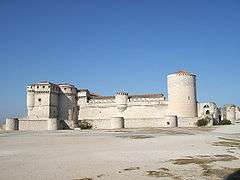
The castle is conserved in good condition, and it has been built in different architectural styles between the 13th and 18th century. Much of the castle in the Gothic and Renaissance styles. The military building was extended and transformed in the 16th century, turning it into the palace of the Duke of Alburquerque. During its different building stages, masters such as Juan Guas, Hanequin of Brussels and her son Hanequin de Cuéllar, Juan, Rodrigo Gil de Hontañón, and Juan Gil de Hontañón "el mozo" or Juan de Álava have worked on the castle.
Among its historical owners, stands out Álvaro de Luna and Beltrán de la Cueva, as well as the successive Dukes of Alburquerque. Distinguished guests on it were some Castilian monarchs, as Juan I and his wife the Queen Leonor de Aragón y de Sicilia, that died on it, or María de Molina, that took refuge on this castle when her Kingdom was rejecting her. Also stands out figures as the painter Francisco Javier Parcerisa, or the writer José de Espronceda, the generals Joseph Léopold Sigisbert Hugo and Arthur Wellesley, the Duke of Wellington, who set his garrison barracks in this castle during the Spanish War of Independence.

The Dukes of Alburquerque lived in this castle for centuries until they moved to Madrid to be close to the court. Thereafter their use of the castle was as leisure and holidays palace, abandoning the building slowly. At the late 19th century the castle was almost completely abandoned, and was victim of robberies. In 1938 was a political prison was settled within the castle, and after was established also a sanatorium for prisoners affected by tuberculosis. It was used as prison till 1966.
In 1972, the Department of Fine Arts carried out an intensive restoration, and made it the home of a Vocational Education school, which continues to this day.
References
- ↑ Escuela Internacional S. L. "Ciudades españolas: Cuéllar y Peñafiel" (in Spanish). Retrieved October 24, 2008.
- ↑ VELASCO BAYÓN, Balbino (2008). Mediterráneo - Meral, ed. Pueblos de España: Cuéllar (Segovia). Photo by Álvaro Viloria. Boadilla del Monte (Madrid). p. 28. ISBN 978-84-935685-4-2.
- ↑ VELASCO BAYÓN, Balbino (1996). Historia de Cuéllar (4th ed.). Segovia. p. 322. ISBN 84-500-4620-3.
Can be looked up online on the data base of protected buildings of the Ministry of Culture by writing in the field "Bien" the name of this monument.
External links
| Wikimedia Commons has media related to Castle of Cuéllar. |
- Ayuntamiento de Cuéllar
- I.E.S. Duque de Alburquerque
- Fundación de la Casa Ducal de Alburquerque y Archivo Histórico de Cuéllar
- Visita teatralizada al Castillo de Cuéllar
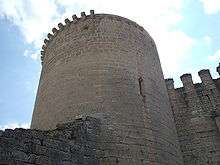 |
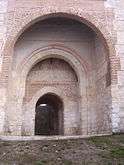 |
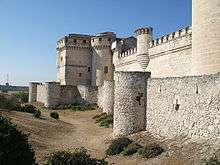 |
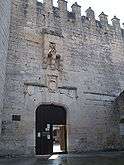 |
Homage Tower, door, foss with the falsabraga (curtain wall) and the entrance.